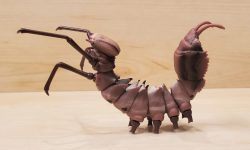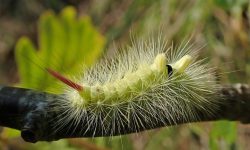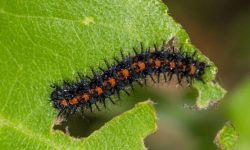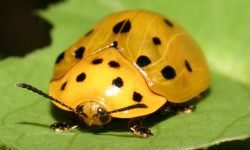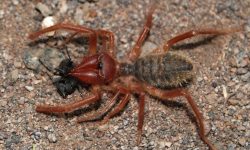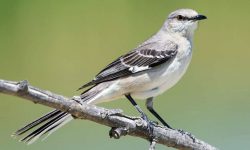White caterpillars are the second part of the four-stage life cycle of moths and butterflies. These caterpillars are the most conspicuous for easy identification from various regions around North America.
Common types of white caterpillars are the hickory tussock moth caterpillar, sycamore tussock moth caterpillar, American dagger moth caterpillar, fall webworm, and Virginian tiger moth caterpillar.
These caterpillars go through multiple instars before turning into adult butterflies or moths. Some species will have white color throughout the larval stage, while others are white at a specific growth stage.
White caterpillars can be seen individually or in groups on the underside of leaves. If not controlled in advance, white caterpillars can cause defoliate your crops. We recommend learning how to get rid of caterpillars naturally.
Identifying different kinds of white caterpillars in your garden can be a challenging and intimidating experience. This identification guide provides pictures and descriptions of various white caterpillars in your garden or woodland.
Are White Caterpillars Poisonous?
Most white caterpillar species are non-poisonous and non-venomous. These crawling insects do not pose threat to humans and other animals. But this does not imply that white caterpillars cannot defend themselves from potential predators.
Some white caterpillar species can cause skin redness, irritation, and a prolonged period of rashes on humans or animals. Puss white caterpillars have spikes connected to venomous glands and can inject venom after stinging.
We recommend using protective gear when handling all caterpillars. Besides that, avoid touching caterpillar species found in the woodlands and parks since they are known to sting and cause skin irritation.
Different Types of White Caterpillars
White caterpillars are the most recognizable crawling insects in your garden. Here are the 20 most common white caterpillars with pictures in your backyard garden:
Hickory Tussock Moth Caterpillar
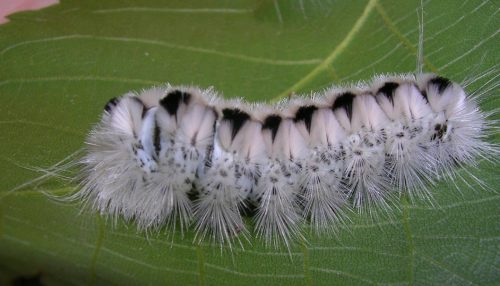
Hickory tussock moth caterpillars are native to Northeastern US regions and feed on the leaves of hickory, walnut, oak, maple, and birch trees. They appear in groups on the leaves’ underside.
The white and black tufts of hair make these caterpillars recognizable. Besides that, the black clumps of hair create a black stripe on their white body. The black head and black dots on the sides are also conspicuous.
Hickory tussock moth caterpillars do not belong to the venomous caterpillar category despite having stinging hairs. But these hairs can cause allergic reactions and pain when they rub against the human skin. (Sources: National Center of Biotechnology).
Research shows that exposure to hickory tussock moth caterpillars can lead to mild or intense skin irritation and rashes. We recommend seeking immediate medical attention since there is no effective home remedy.
Hickory tussock moth caterpillars turn into vibrant orange-brown moths with white blotches on their wings. These moths are usually hairy with pale-brown bodies and tan-colored heads.
Scientific Name |
lophocampa caryae |
Host Plants |
Hickory, walnut, birch, willow, maple, and oak trees. |
Identification Features |
White and black hairs with black dots along the sides. |
What They Turn Into |
Orange-brown moths with white blotches on the wings. |
Sycamore Tussock Moth Caterpillar
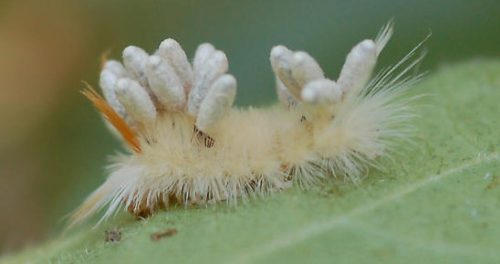
These are hairy yellowish caterpillars that range from small to medium. Sycamore tussock moth caterpillars hail from Canada, Eastern US, and Northeastern Mexico. They feed on leaves from alder, birch, ash, elm, hickory, hazel, and oak trees.
Sycamore tussock moth caterpillars have furry white bodies with two long tufts of orange and white hairs at each end. The hairy body can cause skin irritation and pain when it comes into contact with the skin.
These furry caterpillars turn into pale-blue winged moths. We recommend using pesticides to eliminate sycamore tussock moths from your backyard trees since they can cause defoliation. But small birds can eat them before they start multiplying.
Scientific Name |
Halysidota harrisii |
Host Plants |
Alder, birch, maple, oak, hazel, and hickory |
Identification Features |
Hairy white body with two long tufts of orange and white hairs on each end. |
What They Turn Into |
Pale-blue winged moth |
American Dagger Moth Caterpillar
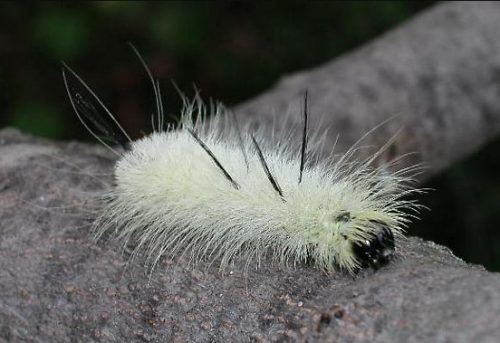
These fuzzy caterpillars are native to North America since they feed on the leaves of alder, elm, maple, and willow trees. American dagger moth caterpillars dwell in the yards, forests, parks, and woodland during the growing season.
These caterpillars have fine whitish hairs with two pairs of long black tufts on their back and tail. The shiny black head and two greenish stripes along the back make these caterpillars identifiable.
The white American dagger moth caterpillars are non-poisonous though the hairs can cause skin irritation. We recommend handling these caterpillars with ultimate care when removing them from the host plants.
Scientific Name |
Acronicta americana |
Host Plants |
Elm, maple, oak, birch, alder, and willow trees. |
Identification Features |
Fine whitish hairs with two pairs of long black tufts on its back and tail. |
What They Turn Into |
Gray-brown moth with dark markings on its wings. |
Fall Webworm
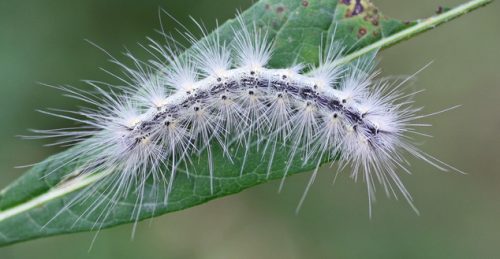
These furry caterpillars are native to North America and are invasive pests in Asia and Europe. Fall webworms feed on leaves from pecans, sourwood, persimmon, and other ornamental trees.
These caterpillars have long, wispy white hairs with two rows of black dots on their back and rounded blackheads. But fall webworms can have bright red or dark shiny black heads, depending on the weather.
Fall webworms do not grow longer than 1.4 inches since they have a short larval period. These furry caterpillars turn into white moths with black-speckled markings on their forewings.
Scientific Name |
Hyphantria cunea |
Host Plants |
Sourwood, persimmon, and pecans |
Identification Features |
Long wispy white hair with black spots on its back and a round black head. |
What They Turn Into |
White moth with black-speckled markings on the forewings. |
Virginian Tiger Moth Caterpillar
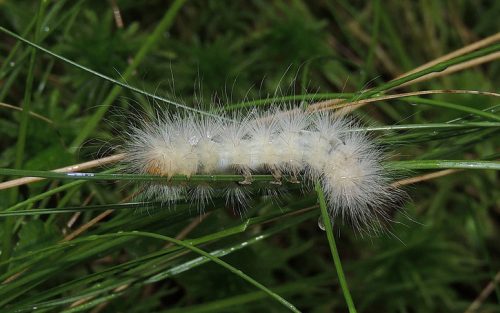
These caterpillars are native to Virginia, but some can be found in Southern Canada and Central America. Virginian tiger moth caterpillars feed on low-growing plants like thistles, docks, dandelions, and plantains.
These furry caterpillars have a spiky appearance and grow up to 1.77 inches. The tufts of creamy white or tan-white hairs make them distinguishable from their yellow-bear counterparts.
Virginian tiger moth caterpillars turn into white moths with a row of black dots on their bodies. These pale to dark brown caterpillars are destructive in the late summer, and we recommend using a chemical treatment to eliminate them.
Scientific Name |
Spilosoma virginica |
Host Plants |
Dandelions, docks, and thistles |
Identification Features |
Tufts of creamy white or tan-white hairs |
What They Turn Into |
White moth with a row of black dots on its body. |
Spotted Apatelodes Caterpillar
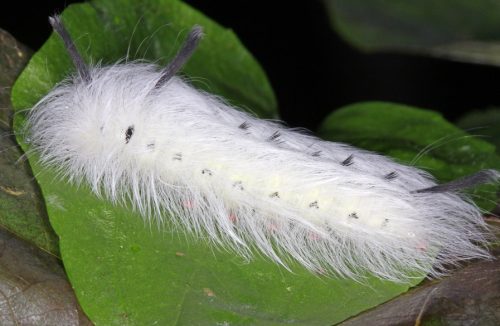
These spotted apatelodes caterpillars are common in southern Ontario, Florida, Texas, and Wisconsin. These white fuzzy caterpillars feed on the leaves of ashes, maples, oaks, and prunus trees.
These caterpillars have wispy white hairs with conspicuous long black tufts on their backs and black spots along the sides. These distinctive caterpillars can grow up to 1.77 inches long with body coloration changing from each stage.
Scientific Name |
Apatelodes torrefacta |
Host Plants |
Ashes, maples, oaks, and prunus species |
Identification Features |
Wispy white hairs with long black tufts on the back and black spots along its sides. |
What They Turn Into |
Moth with forewing gray with brown lines and shading. |
White-Marked Tussock Furry Horned Caterpillar
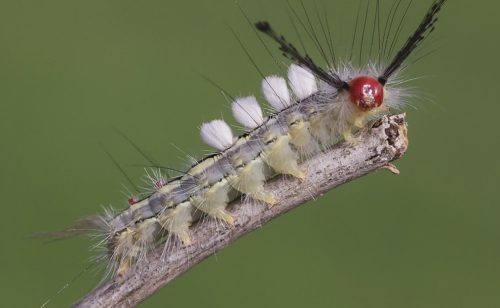
These hairy caterpillars love feeding on the leaves of coniferous and deciduous trees resulting in cosmetic damage. White-marked tussock horned caterpillars can defoliate hickory, larch, elm, birch, willow, and black locust trees.
These caterpillars have bright colors with four fluffy white hairs on their backs and tufts of pencil hairs around their bodies. The redhead with black and yellow stripes makes these furry caterpillars conspicuous.
White-marked tussock furry horned caterpillars hail from Florida. They turn into white or yellow moths depending on the caterpillar species. We recommend handling the caterpillars with care since the stinging hairs can irritate your skin.
Scientific Name |
Orgyia leucostigma |
Host Plants |
Oak, maple, larch, birch, willow, and black locust trees. |
Identification Features |
Four fluffy white hairs on the back and tufts of pencil hairs around the body. |
What They Turn Into |
White or yellow moth. |
Domestic Silk Moth Caterpillar
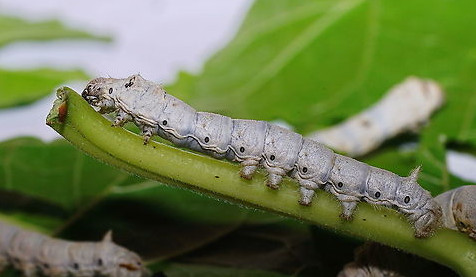
These white silkworm caterpillars feed on mulberry leaves and other deciduous trees. These domestic silk moth caterpillars are native to China and help in commercial silk production.
Domestic silk moth caterpillars are also known as mulberry silkworms. People usually harvest their cocoons to produce high-quality raw silk for the cloth industry. These caterpillars are non-stinging and non-venomous.
Domestic silkworms have white-slender bodies with yellowish horns on their tails and a row of black spots along their sides. The three pairs of spotted front legs can also be used to identify domestic silk moth caterpillars.
Scientific Name |
Bombyx mori |
Host Plants |
Mulberries |
Identification Features |
White-slender body with yellowish horns on the tail and three pairs of spotted front legs. |
What They Turn Into |
Blond to light brown moth |
Catalpa Sphinx Caterpillar
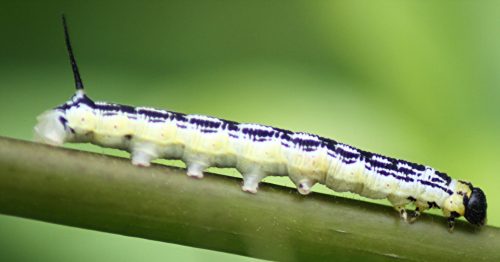
These are stout-bodied white-horned caterpillars with a pale-yellow and black heads. These white grubs also have a row of black dots and a prominent black tail horn for easy identification.
These large caterpillars feed on the leaves of catalpa trees and are also known as white Catawba worms. The catalpa sphinx caterpillars turn into pale brown sphinx moths with hairy bodies and triangular wings.
Scientific Name |
Ceratomia catalpa |
Host Plants |
Catalpa trees |
Identification Features |
White body with black head and row of black dots along its sides. |
What They Turn Into |
Pale brown sphinx moth |
Virginia Ctenucha Caterpillar
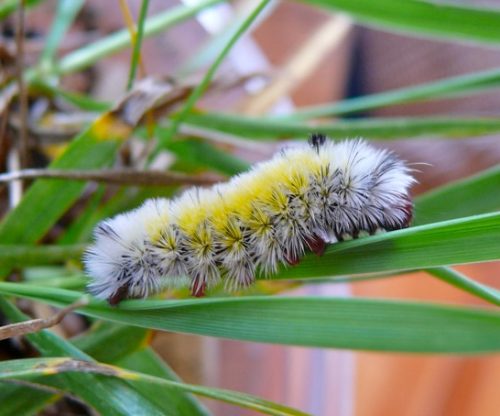
These are types of fuzzy caterpillars in Virginia and other parts of Ontario. The Virginia ctenucha caterpillars have a dense creamy-white tuft of hairs around their bodies to give them a whitish appearance.
Other identifiable features are the dark red prolegs, black-red shiny head, and white to yellowish tufts of bristles. These small caterpillars have a body size that ranges from 0.8 to 1 inch long.
These grubs love feeding on grasses and iris plants. These caterpillars change their body color to dark black when about to reach the pupation stage. We recommend handling these grubs with care since their hairs can sting.
Scientific Name |
Ctenucha virginica |
Host Plants |
Grasses and iris plants |
Identification Features |
The small furry white caterpillar turns dark black when approaching pupation. |
What They Turn Into |
Metallic blue moth |
Hieroglyphic Moth Caterpillar
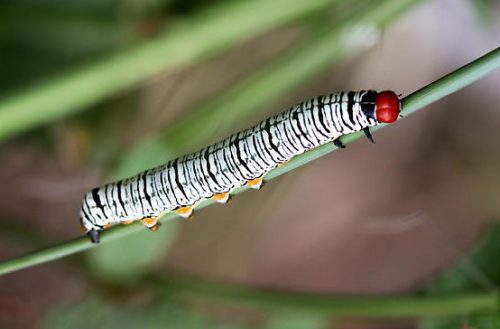
It is another type of stripped caterpillar that hails from Central and South America. The white caterpillar has bands of black and gray around its body. Other identifiable features are white and black legs with an orange head.
The Florida caterpillar can damage crops and defoliate trees. These stripped grubs love feeding on the leaves of sweet potatoes, pecans, and soybean plants. Use pesticides to kill heavy hieroglyphic moth caterpillars infestation.
Scientific Name |
Diphthera festiva |
Host Plants |
Pecans, sweet potatoes, and soybean plants |
Identification Features |
Creamy-colored body and grayish-black bands around the cylindrical body |
What They Turn Into |
Moth with lemon yellow forewings |
Rubber Tree Caterpillar
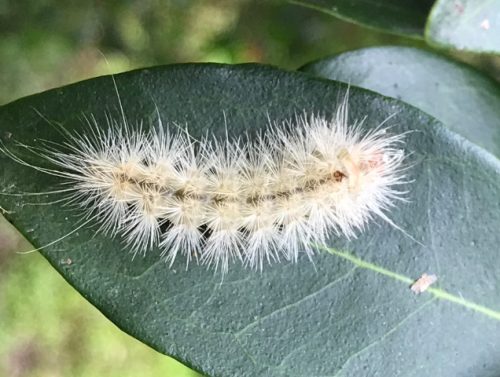
It is a pale-yellow or yellowish-white caterpillar with a spiny appearance. The furry caterpillar has white spines that turn deep yellow when the grub approaches pupation. It also has a crimson red and white head with orange tufts for easy identification.
Rubber tree caterpillars feed on the leaves of ficus trees, and you can also find these caterpillars in your backyard garden in Florida. These grubs turn into Edward’s wasp moth after pupation.
Scientific Name |
Lymire edwardsii |
Host Plants |
Ficus trees |
Identification Features |
Furry white or yellow caterpillar |
What They Turn Into |
Edward’s wasp moth |
Dogwood Sawfly Caterpillar
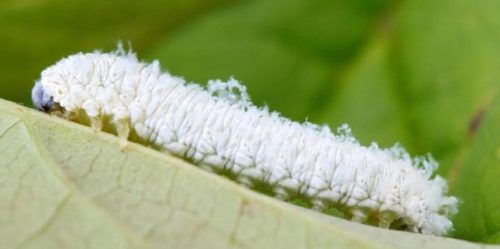
These grubs are vibrant white fluffy caterpillars with yellow legs. These fuzzy caterpillars love munching the foliage of dogwood plants and grow up to 0.8 inches long. A mature caterpillar is more translucent with a yellowish head.
The creamy-white caterpillars rot in wood over winter, and sawflies emerge the following spring. But these grubs are destructive in mid to late summer before switching to pupation.
Scientific Name |
Macremphytus testaceus |
Host Plants |
Dogwood shrubs and tres |
Identification Features |
White and waxy coating in the second instar before becoming yellow and black. |
What They Turn Into |
Dogwood sawfly |
Figwort Sawfly Caterpillar
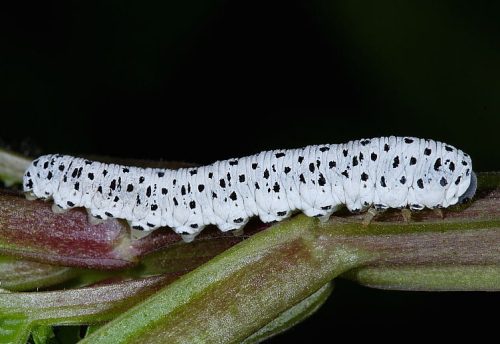
It is a stout white caterpillar with black spots around its body. The stout grub can grow up to 1.18 inches long and loves feeding on figwort plants in the late summer through early fall.
Other recognizable features are the sausage-like body, crinkled appearance, grayish-black head, and slightly tapered tail end. The larva turns into a small black wasp-like sawfly with yellow stripes after pupation.
The main difference between the figwort sawfly and the wasp is that the former lacks a thin waist like the latter. But the figwort sawfly caterpillar does not sting and belongs to non-venomous species.
Scientific Name |
Tenthredo scrophulariae |
Host Plants |
Figwort plants |
Identification Features |
Fat dusty-white caterpillar with black spots and a crinkled appearance |
What They Turn Into |
Small black wasp-like sawfly with yellow stripes. |
Black-Waved Flannel Moth Caterpillar
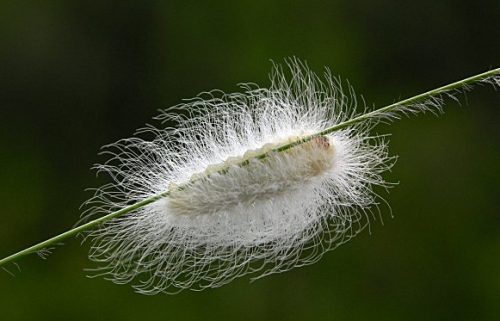
It is a white or cream white caterpillar vulnerable to color change in all its instars. The furry caterpillar belongs to the stinging species, and we recommend refraining from handling them.
Skin rashes, pain, burning, and itching are the first reactions of the stings from black-waved flannel moth caterpillars. These grubs feed on the leaves of trees and shrubs from May to October.
Scientific Name |
Megalopyge crispata |
Host Plants |
Deciduous Trees and shrubs |
Identification Features |
Oval-shaped body with long white hairs that resembles a tuft of cotton. |
What They Turn Into |
Long-haired and creamy moth |
Large Tolype Moth Caterpillar
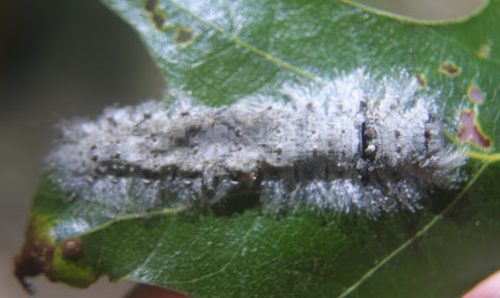
Large tolype moth caterpillars are white-gray and hail from the Eastern US regions. The caterpillar species are common from July through August. They feed on the leaves of wild roses, aspen, and beech trees.
These caterpillars have fine hairs around their body with some black dots on their back for easy identification. We recommend refraining from handling the grubs with your hands since the hairs can sting.
Scientific Name |
Tolype velleda |
Host Plants |
Ash, apple, birch, elm, oak, and plum. |
Identification Features |
Black spots on the middle of the thorax back with hairy legs. |
What They Turn Into |
Small moth with pale to dark smoky gray colors. |
Southern Tussock Moth Caterpillar
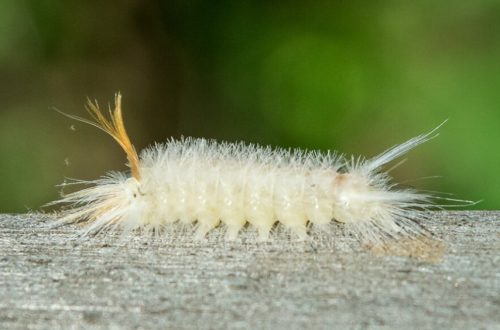
The moth caterpillar has a short and wide body with long white hair. The orange and black tufts are the identification features ideal for classification. The small grubs usually spin silk around the leaves of their host plants.
The thick silk web protects the caterpillar from potential predation. Besides that, these caterpillars are more active from late march to mid-July. They turn into adult moths that are impossible to spot during the day.
Scientific Name |
Dasychira meridionalis |
Host Plants |
Cherry, birch, apple, oak, and some coniferous trees. |
Identification Features |
Long antennae with orange and black tufts. |
What They Turn Into |
Earthy brown moths with shades of green and purple. |
Spiny Oak-Slug Moth Caterpillar
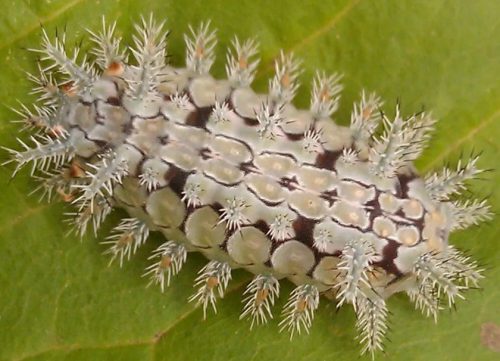
Spiny oak-slug moth caterpillars come in different colors such as white, white-yellow, white-gray, orange, and green. These white grubs occur in small groups and are native to North America.
These caterpillars feed on the leaves of birch, apple, oak, hickory, basswood, beech, cherry, chestnut, hackberry, and more. If you have these trees in your backyard, there is a high chance of encountering spiny oak-slug moth caterpillars.
Scientific Name |
Euclea delphinii |
Host Plants |
Cherry, chestnuts, hackberry, blueberry, ash, basswood, and oak trees. |
Identification Features |
Flattened and ovoid outline with spiny tubercules along the back and sides. |
What They Turn Into |
Hairy brown moth with shades of green patches on the wings. |
Planthopper Parasite Moth Caterpillar
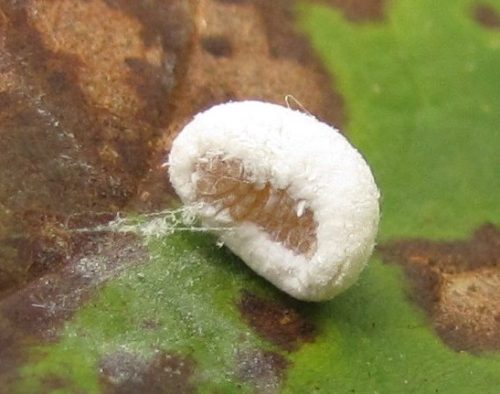
The caterpillar has a pure white body covered in a short tuft of hair. The white grubs prefer to eat small insects and not leave trees. The carnivorous caterpillar loves feeding on planthoppers in the garden.
These parasitic moth caterpillars only suck fluids from planthoppers for nutrition. They also chew the abdomen of these small insects in the last instars of their life cycle before undergoing pupation.
Planthopper parasite moth caterpillars are native to North and Central America. They are common in Southern regions of California, Texas, Arizona, and New Mexico in late summer to early fall.
Scientific Name |
Fulgoraecia exigua |
Host Plants |
Planthoppers |
Identification Features |
Pure white body with short fur-like hairs |
What They Turn Into |
Dark gray moth with dusty white shades |
Scarlet-Bodied Wasp Moth Caterpillar
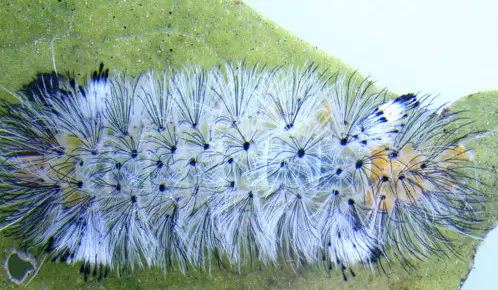
These white caterpillars are native to Florida and occur in multiple broods. The white color is dominant from the first and second week of the initial instars. Besides that, these grubs are usually hairless in the first instars.
The scarlet-bodied wasp moth caterpillar usually grows white hairs that later become black with yellow ventral colorings. These larvae feed on the Florida Key hempvines and also provide a host for the female adults to lay their eggs.
These non-stinging caterpillars fall from the hempvine after the first instars. We recommend not handling them since the hairs can cause skin irritation. You can use a chemical treatment to eliminate them from your garden or backyard.
Scientific Name |
Cosmosoma myrodora |
Host Plants |
Hempvine plants |
Identification Features |
White and hairless in the first instars. |
What They Turn Into |
Black and orange wasp moth with few black hairs. |
Final Thoughts from Experts
White caterpillars have long and soft bodies with six legs and several prolegs. The white color makes these crawling insects conspicuous for easy identification. However, white caterpillars are uncommon compared to their counterparts.
The identification features of white fuzzy caterpillars are black spots, yellow-white or white setae, and protrusions on their bodies. Some species have smooth bodies for easy identification. (Source: University of Missouri-Columbia).
Examples of venomous white caterpillars are hickory tussock moth caterpillars and woolly bear caterpillars. We recommend not handling all caterpillars to avoid stings or skin-level allergies.
We hope this identification guide helped you identify different types of white caterpillars in your yard. Feel free to share the information with your friends or family members growing crops in the backyard garden.
People Who Read This Also Read:

